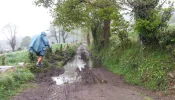Flig
Member
- Time of past OR future Camino
- Primitivo Sept 2021
So after a bit of research and more than one failed attempt using a wooden staff (actually slowed me down) and at my wife’s urging I decided to give trekking poles a chance. I used them a few times on both road and trail for short trial runs. I needed to learn how to use them and not be a danger to myself (tripping hazard) or others (harpooning people is seen as a little rude now it seems).
After I felt I had the hang of them I wanted to do a 15k route with with hills and about a third of the distance on hardball. My target pace for a paved route is about 6 kph and approximately 5 kph moving average on unpaved but good ground. I must have focused a bit too much on those Nordic walking videos as my average moving speed was 6.8 kph and 5.5 overall. That worked out to 15k in 2:10. OK, not exactly Flash speeds but I traveled a lot faster with the poles than I did without. Actually it was a bit too fast. I don’t think my body would be able to stand up to that pace for between 5 & 6 hours a day for weeks at a time. I’ll need to recalibrate my pace over the next few weeks before I do myself a mischief.
tldr: poles made me way faster, but threw off my walking pace. Trekking poles for the win.
After I felt I had the hang of them I wanted to do a 15k route with with hills and about a third of the distance on hardball. My target pace for a paved route is about 6 kph and approximately 5 kph moving average on unpaved but good ground. I must have focused a bit too much on those Nordic walking videos as my average moving speed was 6.8 kph and 5.5 overall. That worked out to 15k in 2:10. OK, not exactly Flash speeds but I traveled a lot faster with the poles than I did without. Actually it was a bit too fast. I don’t think my body would be able to stand up to that pace for between 5 & 6 hours a day for weeks at a time. I’ll need to recalibrate my pace over the next few weeks before I do myself a mischief.
tldr: poles made me way faster, but threw off my walking pace. Trekking poles for the win.
Last edited:
























